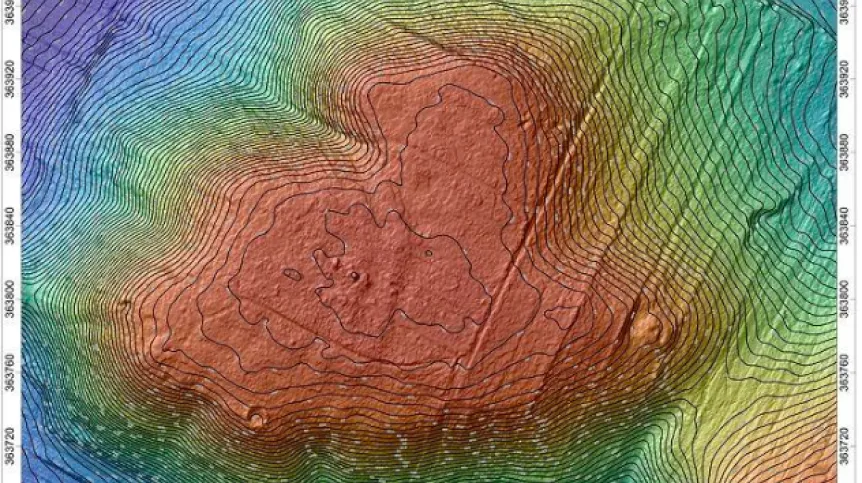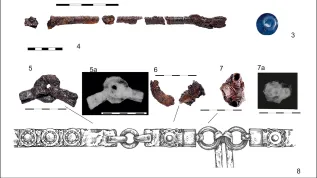
The oldest Polish mausoleum in the shape of a pyramid, the Arian Tower in Krynica (Lublin province), was built in the place of the early medieval hill fort from the period of early tribes. Scientists have determined this using airborne laser scanning.
The Arian Tower in Krynica was built in the beginning of the 17th century. It is the oldest tomb in Poland with a pyramid-shaped structure on top. It was the final resting place of a nobleman, Paweł Orzechowski, chamberlain of Chełm. Because he was an Arian - follower of a nontrinitarian doctrine - it was known in advance that there would be no place for him at a Catholic cemetery. That is why the nobleman decided to build such an eccentric tomb, researchers say.
A detailed plan of the hill on which the tomb is located is not available. In late January and early February 2018 scientists determined that there had been ramparts on the hill. This was a new discovery. "There are many indications that these are the remains of an early medieval hill fort" - says Konrad Grochecki, archaeologist from the Regional Museum in Krasnystaw and a PhD student at the Institute of History of the Maria Curie-Skłodowska University in Lublin.
The discovery was made with airborne laser scanning. ALS allows to make very accurate measurements. The map was prepared by Anna Kubicka from the Wrocław University of Science and Technology, based on the Main Office of Geodesy and Cartography data analysed by Grochecki.
The outlines of ramparts on the surface of the earth are very difficult to spot, which is why they have not been known even to the local conservator. But accurate measuring equipment revealed small differences in the terrain elevation. According to Grochecki, the shape, size and layout of the ramparts indicate that it was an ancient hill fort.
According to the archaeologist, the hill had two lines of ramparts. They separated the lower part of the hill from the steeper and higher part, where the mausoleum crowned with a pyramid stands today. The width of the outer rampart is approx. 8 m. Its maximum height is currently approx. 40 cm. According to Grochecki, the inner rampart probably had similar dimensions. The area within the ramparts was 1.4 ha.
Grochecki notes that the fort is still a hypothesis, but historical documents support it. At the time of the construction of the mausoleum (early 17th century), the hill was referred to as "horodysko" - the word means a place where a fort used to be. This could mean that 400 years ago its relics were more visible, the archaeologist says.
In addition, in the text of the prenuptial agreement of the son of Paweł Orzechowski (for whom the pyramid was built) there is information that he wants to be buried in the pyramidal mausoleum "together with his ancestors". "This phrase indicates that the hill was known for its earlier, long history, perhaps related to the early tribal past, the times before the creation of the Polish state" - Grochecki believes. In the first half of the 17th century, noble families building their identity would often refer to very distant and even mythical traditions.
The scientist also has another hypothesis regarding the function of fortifications. He suggests that there could be a dissenter cemetery in that place and the ramparts marked its borders.
"Whichever hypothesis is true, everything indicates that the hill was chosen for the construction of the pyramid because of its long history. There is also another, higher hill nearby, but it was not chosen for the construction of the mausoleum" - says Grochecki.
The archaeologist plans to verify his hypotheses and conduct excavations in the places where the relics of the embankments are located. Last year, he only examined a part of the mausoleum foundations. During those excavations, no fragments of vessels or other remnants were discovered that would help confirm the hypothesis about the location of a medieval hill fort in this place.
According to Grochecki, the mausoleum is in poor repair. Thanks to the funding awarded by the municipal office in Krasnystaw, its renovation will take place next year. The last extensive conservation work on the structure took place in the 1950s, because the mausoleum was damaged during the Second World War.
PAP - Science in Poland, Szymon Zdziebłowski
szz/ zan/ kap/
tr. RL

















